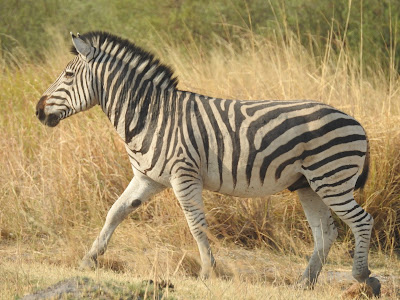After our first camp, we’re off this morning for Kwando Lagoon Camp. We had met the pilot, Alex, the previous night at dinner as she stayed overnight at Setari to fly out the next morning with a group of travellers which included Judith and I. We’ll be travelling with a young couple and the woman admitted at dinner that she gets motion sickness. Alex indicated that it’s better if she looks straight at the horizon, and not to the side. She invited her to sit in the co pilot seat. I thought it was a nice touch particularly if it didn’t work, she’d have someone barfing in the seat beside her.
We didn’t pack the night before so we were too late to have the porters take our luggage to the main lodge. We hoofed them over when we finished — not a big deal but I’ve gotten used to having that part of the travel looked after. My step counter placed the distance from our tent to the main lounge to be about 725 steps. Setari had over 1.8 km of elevated walkway so I never had any problems getting my steps in.
I put down my carryon bag on one of the chairs in the lounge to say good-bye to the staff and managers. They were excellent hosts and we really enjoyed our stay. We then gathered our bags and got into the van to make the short drive to the river’s edge to board our boat to the airport. It’s there that I realize I left my cap that I recently got for helping at the Golf for Kids event. Dang. I let my driver know I left it on the chair in the lounge and that he could keep it.
The boat was fun but uneventful. We arrive at the airport dock and disembark while a small fleet of Setari staff that were already waiting at the airstrip came and brought all our bags to the spot where Alex and the plane were waiting. We board the plane and take our seats.
 |
| Pilot Alex |
In the air, you can see how dry the area is. There are large swaths of land that would normally be filled with water, but they were bone dry. There were dozens and dozen of dry watering holes that I thought should normally have some water remaining, but were completely dry. We disembark at the second stop and when we land, we’re greeted by Gee and James, our Guide and Tracker team. We learn that some of the staff shorten their name to the first initial or a combination of letters because tourists can’t pronounce or remember their names. We did ask Gee what his full first name was and yes, I can see why they just use their initials.
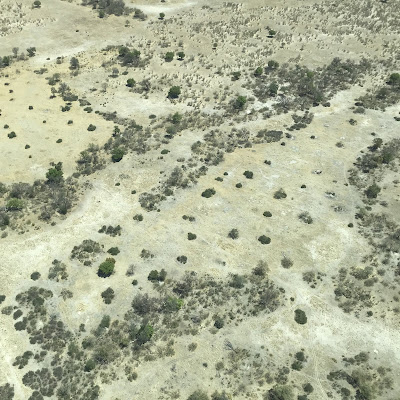 |
| The dry landscape. Some of this area would normally be underwater. |
The vehicle of choice for these land based camps are Toyota Land Cruisers that have been outfitted with a canvas shade over top of the roll bars. There are 9 seats for passengers and two seats in front for the driver and passenger. The tracker usually sits in a chair welded to front of the vehicle on the opposite side of the driver, which allows him or her (yes there are female trackers and guides although they are very rare) unobstructed views to look for wildlife and see the tracks in the sand. When they are near the big cats (lions, leopards or cheetahs) they come inside the vehicle for safety reasons. The cats see all the people in the land cruiser as one integrated unit so they are unlikely to attack something as large as a Land Cruiser.
 |
| Safari Land Cruiser with guide Gee and Tracker James |
The trackers and guides all have to take a course. It’s the same course; if you pass with 75% or more you are eligible to become a guide and between 50% to 75% you’re at the tracker level. There was a strong demand for the graduates, but over the past few years, the supply of graduates is outpacing the demand, so some are waiting 2 years before they can find work.
We climb into the truck. Judith manages a one arm climb — it looked painful but she was eventually able to figure out something that didn’t require her to lift her right arm too high. The “roads” are pretty rough. You definitely need a high clearance 4x4 to get around. Gee indi`cated we would go and see the two cheetah brothers first as they had been tracked that morning and knew where they were. Usually cheetahs find some shade in the afternoon to rest during the heat of the day before going out later to hunt when it’s a bit cooler.
When we drove up to the cheetahs, James moved inside the car well before we arrived at the shade tree where the cheetahs would be resting. I was surprised just how close we drove up to them and that they didn’t move or flinch when we stayed there. The engine is shut off when we’re viewing them. The cats are habituated with having vehicles drive up to them, having experienced this since they were cubs. They know that the vehicles don’t do anything to them so they don’t run away or move when we show up.
 |
| Add caption |
 |
| Add caption |
The cheetahs are pretty amazing and beautiful. Judith remarks that it looks as if they could be petted; I respond by indicating that would quickly cure her shoulder problem. There weren’t many animals during the trip that she didn’t want to pet except for maybe the hippos and the Cape buffalo.
We stayed for a long time and then proceeded over to the camp itself. Lagoon camp overlooks a river which still has lots of water. Wallowing in the river were about a dozen hippos. In the distance was about 6 or so elephants at the edge. It was so cool to have this site. The manager, Lizzy, invites us to have a seat in the lounge to do the registration and sip on a cool drink which reminds me of a non-alcoholic Singapore Sling. There are some interesting rules including a big one that we must be escorted to and from our rooms after it becomes dark. There is no fencing for the camp and animals (including predators) can walk into the camp whenever they want. They’re unlikely to do it during the day, but night is the time when they’re most active. I was curious about the rule and asked one of the guides if there had been any instances before the escort rule was put into place. He said yes. I didn’t ask for any details—I thought it was best not to know.
The manager showed us our room. It ends up being one of the furthest from the main areas but has a great view of the water with hippos and other wildlife. Here are the pics:
 |
| View of the river through the indoor side of the screen. |
 |
| View as you enter from the front door. |
 |
| Outside deck by the front door |
 |
Dressing area behind the headboard wall. The bathroom is behind the curtain.
The far door goes to the outside shower. |
 |
Add caption
The bathroom tub in front of a mesh screen with.a river view.
I guess it was positioned so you could practice your hippo moves.
The indoor shower is positioned behind the diagonal wall
The toilet is in a separate water closet behind me. |
 |
The outdoor shower.
It did feel as if you needed to apply sunscreen to use it. |
The camp had a similar set up as the previous camp at Setari. There were central buildings that had a guest lounge area, a long dining room table where all the shared brunches and dinners take place, a swimming pool in case you need to cool off from the mid day heat. The bar and drinks are self serve.
In this camp its an earlier rise. The guide comes and knocks on your door at 5:30 for your morning alarm. Breakfast is at 6:00 am so that you can take in the morning safari ride which starts promptly at 6:30 am. The safari goes until 11:00 and sometimes you have time to go back to your room before brunch is served at 11:30. After brunch you can retire to you room or go for a swim until high tea at 3:30 pm before the 4:00 pm afternoon/evening safari that goes to about 7:30 pm. Both morning and afternoon safaris have a rest break where coffee/tea/beverages are provided along with a light snack. In the camps they don’t let us go more than 2 hours without giving us some type of nourishment. Then dinner at 8:00 and back to your rooms around 9:30 pm. Chill for a bit then sleep. Repeat.
The morning and evening sessions are selected for a variety of reasons. The temperature is the most moderate, the animals are most active then and the morning and late evening light is great for photography. A winning combination all around.
The range between the evening and mid day sun temperatures were amazingly wide. The night would cool down to about 10 degrees and then by 1:00 it would be around 40 degrees. Three or four layers to go out in the morning including a thick fleece and a coat and by 10:00 you’d be down to one. We had a couple of unseasonably cold nights at Lagoon camp where the night time temperatures went down to single digits. The humidity is very dry, around 35%. There’s no heat in the tent so you had to dress quickly those mornings. I am so glad that my last minute packing addition was my packable puffy coat. I almost didn’t bring it because it seemed crazy to bring a down filled jacket to Africa but both Judith and I agreed it was a very useful decision. One of the guides told us about a family that came on safari one year and only brought shorts and T-shirt’s. They cleaned out the gift store of fleeces and long sleeve clothing.
Each morning at 5;30 am our guide knocks on our door to wake us. We quickly get ourselves ready and walk over for breakfast. There is a small selection of cereals, fruit and yogurt. On the fire pit is a big grill with some type of porridge and big kettles of hot water. The porridge alternates between oats one morning and something like cream of wheat the next day. It’s hot and tastes great once I add some honey and granola toppings. The coffee is strong and hot although I restrict my intake to half a cup because while there are unlimited rest stops while on the safari, it does involve roughing it. The driver carries a tissue box and small paper bags to hold the used tissues. Any tissues used must be carried out and disposed of at camp. Ant hills seem to be the rest stop of choice. They are huge, some are over 8 feet in height and even wider in width. The guide circles the spot to make sure there aren’t any creatures lurking behind and that the mound remains active as a termite hill without any burrows dug out that could house other creatures such as snakes. While we never saw any snakes or scorpions, the area is home to many insects and reptiles that could put a big damper on a vacation.
Judith amused herself (and particularly the guides) with wanting to identify the various types of scat. Neither of us were that great at identifying the various antelopes. There were no shortage of elephants, Cape buffalo and zebras. Once you’ve seen 50 of them the excitement starts to wain and we saw more than that. The antelopes and zebras are way more skittish than the big cats and would walk or run away as we approached. There were so many types of birds. And they were so varied in colour, size and every other attribute you could conceive. If you’re into birding, Africa is a great spot. There were too many to remember the names of them but I nevertheless snapped away at them
There was a lot of reference to the “Big Five” of African animals that everyone wants to see: Elephant, Giraffe, Rhinos, Lions and Hippos. We didn’t see Rhinos on this tour; they just didn’t exist in the area of the camps we were at, but we saw everything else. We saw the “Marine Five” on the whale watching tour: Whales, dolphins, seals, penguins, and sharks. We learned about ad saw the “Ugly Five”: Ostrich, Warthog, Maribou Stork, Vulture and Cape buffalo.
The Land Cruisers could go practically wherever it wanted to go. We crossed over shallow water about 2 feet deep, drove over branches and bushes, powered through loose sand and made our way slowly over “hippo highways” — patches of former beds of water frequented by hippos who like to make lots of deep ruts in the soft soil to lie in—think moguls. But mostly we stayed on the roads already carved into the ground. We would fly over grasslands to catch up with predators chasing prey and although we never witness a “kill” it was exhilarating to see the strategy and the chase up close and personal. In the few instances we witnessed, the prey safely ran away or we came across the carcass after the prey had been killed and the predator was gone or just feeding.
We learned about the vegetation and I was particularly fascinated by the leadwood tree. It must be a very dense wood. On part of the reserve where the camp is located, Namibia was on the other side of on of the rivers. A few months ago in May, a spark from the land clearing going on the Namibian side caused a grassland fire in the reserve and several acres burned. You could see new vegetation starting to grow back. Dotted in this field were several lines of white ash where former leadwood trees burned. We learned that these trees are rock hard and when they die, they will stand barren for another 50 years or so before falling over. The amazing thing was that some of these trees will still burning from that May fire, 4 months ago. Incredibly, the fires are not put out, but are left to burn. The reserve managers have a policy not to interfere with nature (even though the original fire was human caused). In any event, the leadwood is a slow burning tree.
 |
| Leadwood tree slowly smoldering. |
We certainly got our fill of wild animals. It seams the first one of whatever type of animal you see is a fabulous experience. But after you see several herds and get up close and personal form many hours, the excitement wanes. However, here are some of the pictures I took, in no particular order.
 |
| Female Kudu |
 |
Warthog. The guides made liberal references to The Lion King Characters.
All the trackers referred to warthogs as "Pumba"
|
 |
Southern Red Billed Hornbill
The guides referred to them as Zazu the character from The Lion King
|
|
The zebras were strong muscular animals.
|
|
 |
Magpie Shrike
The tail seems too long to be true.
|
 |
| Goliath Heron |
 |
| Crocodile |
 |
| Part of a herd, The baby was cute. |
 |
| Black Crowned Night Heron |
 |
| Bateleur. It's a medium sized eagle. |
 |
| Mother Baboon with Baby hanging on |
 |
Tsessebe. This is a medium sized antelope, identified by a sloping back.
They have an acute sense of smell and can detect danger sooner than other
species. Impalas will often hang around tsessebe herds and use them as their
early warning system. In the wild, when another animal starts to run,
you should too and ask questions later. We saw several cases where
someone would start running and all the nearby animals immediately follows,
sometimes running in different directions
|
 |
| Lilac Breasted Roller |
 |
| White Backed Vulture. A member of the Ugly 5 |
 |
| Male Impala |
 |
| Southern Ground Hornbill |
 |
| Sometimes we got close. Fortunately this one decided to ignore us. |
 |
| Gnu (also called Wildebeest) |
 |
| Cape Buffalo. |
 |
| Carmine Bee-eater |
 |
| Kudu. One of the larger antelopes. Only the males have horns. |
 |
| Baboon. This one was staring at me from the roof of the cabin next door. |
 |
Green Wood Hoopoe. The light isn't great in this picture,
otherwise you would see the metallic green sheen on the body feathers.
|
 |
| Little Bee-eater |
 |
| Goliath Heron |
 |
| Giraffe. Note the Oxpecker birds on his back. |
 |
| The close up. This one has a torn ear. |
 |
| Lilac Breasted Roller |
 |
| Tsessebe |
 |
| Red Lechwe |
 |
Hippo. Noisy, particularly at night, much to Judith's dismay.
They tend to stay in the water during the day and feed at night. |
 |
| African Skimmer |
 |
| Cape Buffalo. Mean looking dudes and dudettes. |
 |
A large herd of Cape Buffalos (over 100) coming towards us.
We could see the large cloud of dust they were kicking up in the distance.
The guide sped over and positioned the Land Rover near their path.
|
 |
| Southern Carmine Bee-eater |
 |
| Carmine Bee-eaters digging nests in the sand. |
 |
Nesting grounds for the Carmine Bee-eaters. There are hundreds of birds.
The mating couple dig nests into the sand.
|
 |
| Yellow Billed Stork |
 |
| Female Elephant. She's not very pleased with our proximity. |
 |
| Baboon. They live in troops. |
 |
| White Backed Vulture. |
 |
| Black Backed Jackal |
 |
| Carmine Bee-eater |
 |
Male Lion. We came across two of them resting in the sun. This one seemed
to be the oldest of the two. He was massive, easily 400 lbs. |
 |
| This is the big guy. |
 |
This was the other male lion. Together, they looked after a pride that had
four lionesses and several cubs. |
 |
| Yet another Lilac Breasted Roller |
 |
| Female and Male Red Lechwes. In the background are impalas. |
 |
| Fish Eagle looking 180 degrees behind him. |
 |
| Male Reedbuck. He's smiling for the picture. |
 |
| Male Giraffe. He's also smiling. |
 |
| Newly minted giraffe pellets... |
 |
A Red Lechwe that had been caught and eaten by the two cheetah brothers.
By the time we got here the cheetahs had finished feeding.
Cheetahs typically eat the meat and leave the organs. |
 |
Vultures and Maribou Stork feeding on the Red Lechwe carcass.
The stork hangs around for items that have been separated from the carcass as
their beaks are not shaped to tear off meat. |
 |
| The remains of the Red Lechwe carcass after about 10 minutes. |
 |
| White Headed Vulture |
 |
| Southern Ground Hornbill |
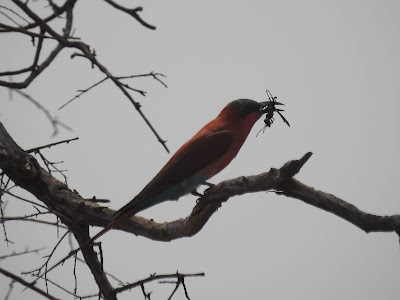 |
| Carmine Bee-eater with a kill. |
 |
Baobao Tree. This one is reported to be 500 years old.
The tree is a succulent so the lack of bark (courtesy of
the elephants) doesn't harm the tree. On the other side of
this tree was a deep hole that was dug out by elephants. The
elephants will chew on the wood fibres for water as it is a
good source of water. |
 |
| Grey Heron |
 |
Crocodile
These were the most skittish animals. It was difficult to get close. |
 |
| Sable. These antelopes were big and had the coolest facial markings. |
 |
Warthog. They kneel to get their tusks close to the ground.
The tusks are used to break up the soil to get their food. |
 |
| The lower tusks are sharpened when they rub against the upper tusks. |
 |
| Zebra. |
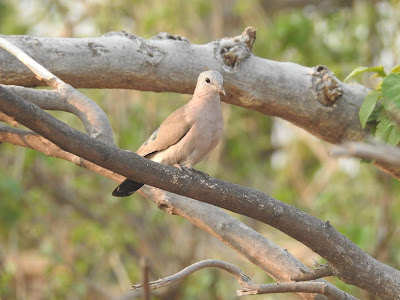 |
| Cape Turtle Dove |
 |
Elephants at the watering hole. The elephant in the back is covering herself
with dirt to protect herself from insects and sun. |
 |
| White Storks |
 |
A porcupine. These animals are usually nocturnal so we were lucky to find
one that was still out in the early morning. |
 |
African Scops Owl. I initially thought this is a baby owl but it is just a
tiny owl. He was in the tree near our breakfast area and was well camouflaged. |
 |
| Gnu |
 |
The two lionesses with their cute cubs. They had just finished feeding and
were on their way to get a drink of water. |
 |
| All the cubs had fat round tummies from gorging themselves. |
 |
| At the water's edge lapping up water. |
 |
| Blue Waxbill |
 |
| The lionesses and cubs having a rest until the temperatures cooled. |
 |
| Bateleur |
 |
| Lilac Breasted Roller |
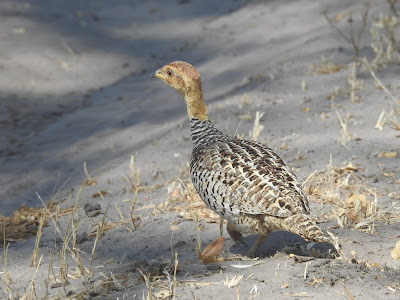 |
| Red Crested Korhaan |
 |
| Another pride of lions. |
 |
| Black Backed Jackal |
























































































